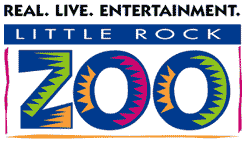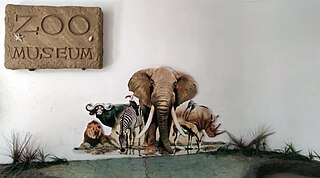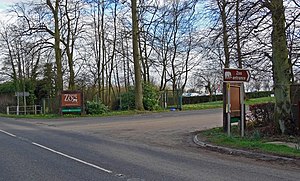
Apes are a clade of Old World simians native to sub-Saharan Africa and Southeast Asia, which together with its sister group Cercopithecidae form the catarrhine clade, cladistically making them monkeys. Apes do not have tails due to a mutation of the TBXT gene. In traditional and non-scientific use, the term ape can include tailless primates taxonomically considered Cercopithecidae, and is thus not equivalent to the scientific taxon Hominoidea. There are two extant branches of the superfamily Hominoidea: the gibbons, or lesser apes; and the hominids, or great apes.

The Philadelphia Zoo, located in the Centennial District of Philadelphia on the west bank of the Schuylkill River, is the first true zoo in the United States. It was chartered by the Commonwealth of Pennsylvania on March 21, 1859, but its opening was delayed by the Civil War until July 1, 1874. The zoo opened with 1,000 animals and an admission price of 25 cents. For a brief time, the zoo also housed animals brought to U.S. from safaris by the Smithsonian Institution, which had not yet built its National Zoo.

The Cheyenne Mountain Zoo is a zoological park located southwest of downtown Colorado Springs, Colorado, on Cheyenne Mountain in the United States. At an elevation of 6,714 feet (2,046 m) above sea level, it is the highest zoo in the country. The zoo covers 140 acres (57 ha), 40 of which are in use. The zoo houses more than 750 animals, representing nearly 170 different species, with more than 30 endangered species. The zoo was ranked the #4 best zoo in North America in 2018 by USA Today. It is accredited by the Association of Zoos and Aquariums.

Dublin Zoo, in Phoenix Park, is a zoo in Dublin, Ireland, and one of Dublin's most popular attractions. Established and designed in 1830 by Decimus Burton, it opened the following year. Today it focuses on conservation projects, breeding programmes, and growing awareness for animals. Its stated mission is to "work in partnership with zoos worldwide to make a significant contribution to the conservation of the endangered species on Earth".

The Monkey World Ape Rescue Centre is a 65-acre (26.3 ha) ape and monkey sanctuary, rescue centre and primatarium near Wool, Dorset, England.

Blackpool Zoo is a 32-acre (13 ha) zoo, owned by Parques Reunidos and located in the sea-side resort of Blackpool, Lancashire, England. It provides a home to over 1,350 animals from all over the world.

The Little Rock Zoo was founded in 1926 and is located in Little Rock, Arkansas, United States. It is home to more than 725 animals representing over 200 species, and covers an area of 33 acres (13 ha). The Arkansas Zoological Foundation is a private 501 c (3) organization that raises funds for zoo development. The Little Rock Zoo is a department of the city of Little Rock. It is the largest zoo in Arkansas, and the only Arkansas zoo accredited by the Association of Zoos and Aquariums (AZA).

Colchester Zoo is a zoological garden situated near Colchester, England. The zoo opened in 1963 and celebrated its 60th anniversary on 2 June 2023. It is home to many rare and endangered species, including big cats, primates and birds as well as many invertebrates and fish species.

Wilhelma is a zoological-botanical garden in Stuttgart in the Bad Cannstatt district in the north of the city on the grounds of a historic castle. Wilhelma Zoo is one of the most popular tourist destinations in Baden-Württemberg, seeing more than 2 million visitors annually.

Leipzig Zoological Garden, or Leipzig Zoo is a zoo in Leipzig`s district Mitte, Germany. It was first opened on June 9, 1878. It was taken over by the city of Leipzig in 1920 after World War I and now covers about 27 hectares and contains approximately 850 species. By 2020 the zoo featured six different theme worlds, aiming at providing habitats appropriate for the species on display.
The Zoo was a New Zealand observational documentary series, made by Greenstone TV, that followed the lives of Auckland Zoo's animals and zookeepers. The series explored the new arrivals and births of Auckland Zoo, to the fights, illnesses and mating rituals, how the animals are fed and how they live. The series' production crew were based full-time at the zoo, but the series also followed zookeepers overseas on zoo-related trips.

The Rosamond Gifford Zoo at Burnet Park is an AZA zoo in Syracuse, New York. It is owned and operated by Onondaga County Parks with support from the Friends of the Rosamond Gifford Zoo. The zoo is home to more than 900 animals representing 216 species on 43 acres (17 ha). Some of the more popular animals include Asian elephants, Humboldt penguins, Amur tigers, a Komodo dragon and the only Giant Pacific octopus exhibit in Central New York. The zoo opened a new Animal Health Center in 2022 that is the largest zoological medical center in New York state outside of the Bronx Zoo.

The Bratislava Zoo is a zoo in Bratislava, Slovakia. It is located in the area of Mlynská dolina in the borough Karlova Ves. Opened in 1960, it is the second oldest zoo in Slovakia. The zoo covers an area of 96 hectares, out of which 35 hectares is open to the public. The zoo receives on average around 300,000 visitors annually.

The ZooParc de Beauval, more commonly called Beauval Zoo or, more simply, Beauval, is a French zoological park located in Saint-Aignan-sur-Cher, Centre-Val de Loire. It features more than 35,000 animals on 40 hectares, which is one of the largest animal collections in France and in Europe. Created in 1980 by Françoise Delord, it is now run by her son, Rodolphe Delord, and managed by his family, which owns most of the capital.

Molly Winifred Badham MBE was a co-founder of Twycross Zoo. She trained the chimpanzees who appeared on the Brooke Bond PG Tips television advertisements in the 1960s to the 1980s.

Metro Richmond Zoo is a privately owned, for-profit zoo in Chesterfield County, Virginia. It is located in the central Virginia area, off of U.S. Route 360, about 20 miles southwest of Richmond. Metro Richmond Zoo encompasses about 70 acres (28 ha) and houses around 2,000 animals representing over 190 species, including reticulated giraffe, white rhinoceros, snow leopard, cheetah and Grant's zebra.

National Zoological Gardens of Sri Lanka is a zoological garden in Dehiwala, Sri Lanka, founded in 1936. It is home to various birds, mammals, reptiles, fish and amphibians. The zoo not only exhibits animals from Sri Lanka, but also exhibits species from across Asian and other parts of the globe.

Gembira Loka Zoo is a zoological garden located in Yogyakarta, Special Region of Yogyakarta, Indonesia. Gembira Loka Zoo was opened in 1956 and comprises a botanical garden, orchid nursery, (artificial) lake, children's park, numerous scenic bridges across the Gajahwong River, and a collection of approximately 470 animals, most notable of which are its native Indonesian tigers, leopards, Komodo dragons, saltwater crocodiles, orangutans, and gibbons, as well as African animals such as lions, camels and hippopotamus. The park is 54 acres in size.
Sarah Nathalie Evans was an English businesswoman and conservationist with a particular interest in primates. In 1963 she co-founded the Twycross Zoo, Leicestershire. She began her career as a dog breeder and pet shop owner before merging her business with that of rival Molly Badham. The pair kept primates in their shared flat before moving, in 1954, to a larger house in Hints, Staffordshire where they established the Hints Zoological Gardens. Evans and Badham trained their chimpanzees to act out tea parties, which was noticed by the Brooke Bond tea company, who contracted the animals for a series of television advertisements for the PG Tips brand. After outgrowing Hints the pair moved their collection to Twycross, Leicestershire where they developed the largest primate collection outside of Japan. The Twycross Zoo became the first in the United Kingdom to breed colobus monkeys and bonobos and is now recognised as the World Primate Centre.

Mogo Wildlife Park is a small privately owned zoo in Mogo, on the south coast of New South Wales, Australia.





















